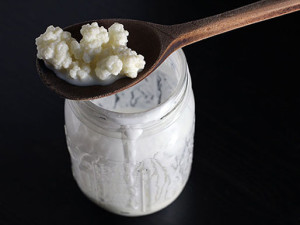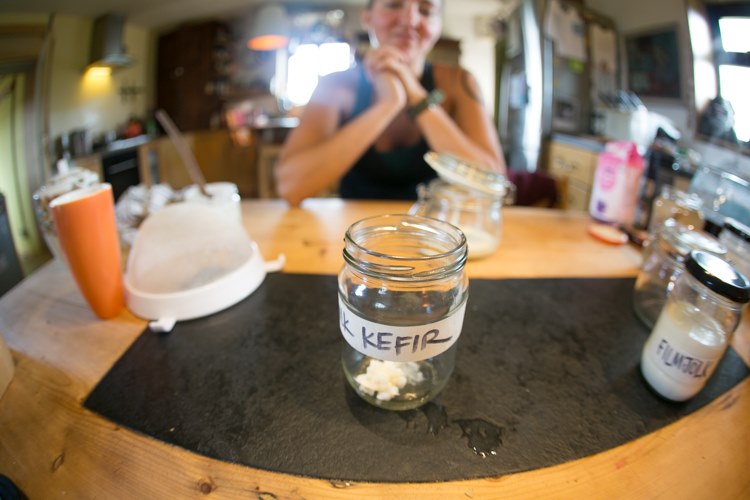Directions on How to Make Milk Kefir.
First you must obtain the grains. These can be purchased (one reputable supplier is the Cultures for Health website) or if you ask around in your community you should find someone who would be happy to share their grains with you.
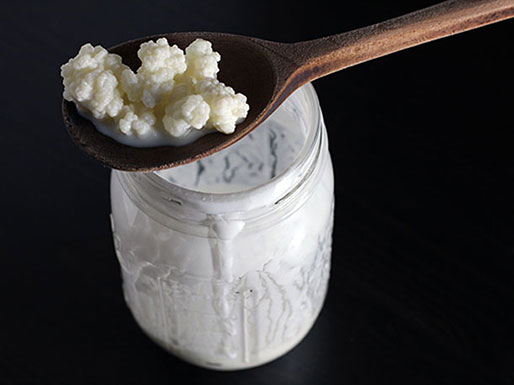
I’d recommend finding some milk kefir grains on the Irish Fermentalists Facebook page- there is often someone near you willing to share. They are not actually a grain at all but a yeast/bacterial fermentation starter. They look like small grains of cauliflower.

The next step is to obtain the best quality milk you can find. This can be organic, raw, unpasteurised cow’s or goats milk. Or, any milk that you are used to drinking will do, as long as it isn’t UHT milk. The grains do best on dairy milk but it is possible to culture nut or soya milks- but you’ll have to read up about how best to do this so that the grains don’t starve over time. Bear in mind that even if you normally avoid dairy products like i do, once the milk has been turned into kefir it will contain little to no lactose so everyone should be able to tolerate it unless there’s a milk allergy to casein. From what I’ve read some of the casein also gets broken down during the fermentation process.
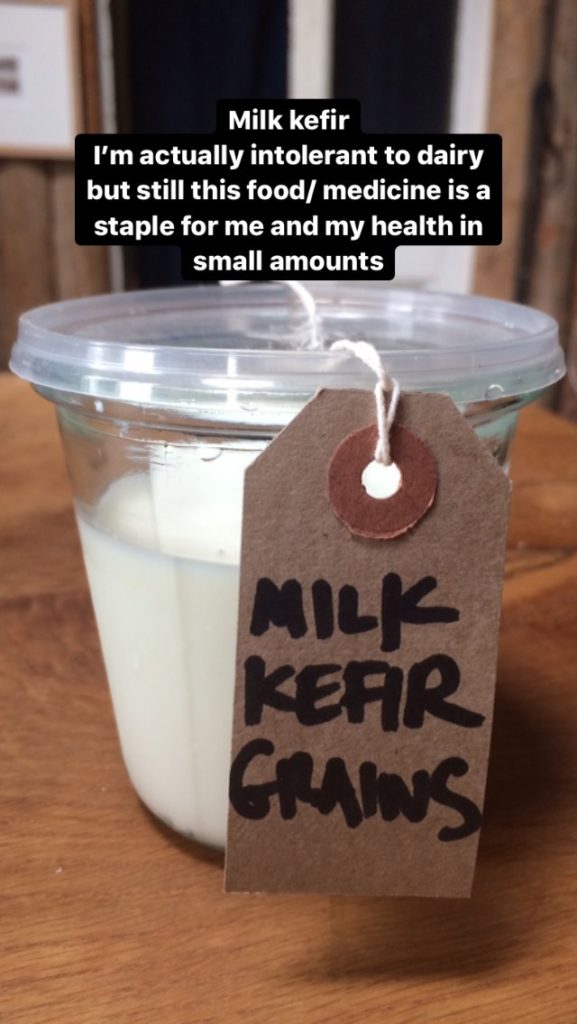
The next step is to place approx 1 teaspoon to 1 tablespoon of grains into a glass jar with anywhere from a cup to 500 ml milk, or whatever amount your family will consume in a day or two. Cover the glass jar with a coffee filter and a rubber band or a clean tea towel and leave it somewhere it won’t be disturbed or forgotten for the next 24-48 hours. Look in on your milk kefir every now and then, give it a stir, and do a taste test. It’s ready whenever you like the taste of it. Normally it will thicken to a consistency like cream or a runny yogurt and have a pleasant yeasty aroma. Depending on the warmth of your room and the grains to milk ratio it can take anywhere from 12 – 48 hours to be kefir. If you find the liquid has started to separate into curds and whey- don’t be alarmed- just stir it all in, strain out the grains and refrigerate the kefir. Next time you could leave it a little less time. The taste will become slightly more sour over time, taste it at various stages and see where you like it best. Strain out the grains with a strainer and repeat the whole process. The milk kefir will keep in your fridge for up to 3 weeks. It’s ok to add the next days kefir to the same container if you still have some left from previous days.
A little about milk kefir in my experience:
Milk Kefir is a fermented dairy beverage- full of health promoting properties. I know that doesn’t make it sound hugely appetising. But, bear with me. This drink has been around for thousands of years. If you imagine yogurt, it’s not much different in appearance and nature. Kefir and yogurt are both good for you in that they contain a healthy dose of probiotics that line your intestines and feed your gut flora and in this way contribute to a stronger immune system. A healthy gut is where it all starts. Kefir has the advantage over yogurt in that it also contains healthy yeasts along with the bacteria. Both products, especially when made with full fat milk also contribute to your daily calcium, protein and vitamin needs. Best thing is, it’s so easy to make at home.
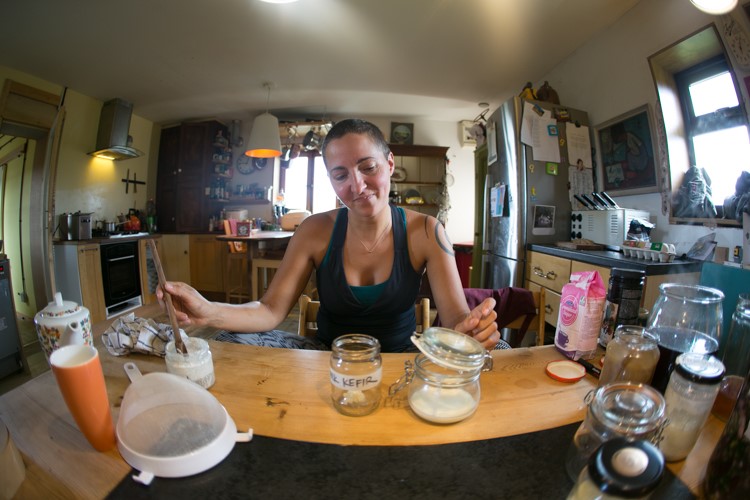
I used to spend a small fortune on quality probiotics from the health shops. I no longer buy them as I get a wider range of these same probiotics along with other strains from fermented dairy products along with kombucha and lacto-fermented veggies such as sauerkraut and kimchi. It feels reassuring to know how to provide my body with what it needs from natural foods rather than relying on what I need to otherwise buy in a bottle from a health shop.
Are you one of the many who suffer from dairy intolerance? I also have never tolerated cow’s milk well, although I was well into my twenties before I realised that this was the problem. It seems to be that my body can’t break down the lactose in cow’s milk well, and drinking cow’s milk, or especially cream makes me feel a strong headache, sore and bloated tummy, along with strong stomach pains, digestive problems and IBS symptoms. For many years I avoided cow’s milk dairy products (I could tolerate goat’s milk no problem- it has a smaller fat globule that makes it easier for humans to digest than cow’s milk does) but in recent years learned that both milk kefir and yogurt- made if possible with organic milk- were no problem to me. In fact there are studies that show that drinking milk kefir can help heal the issues that cause the dairy intolerance. I now find after a year of drinking milk kefir most days I can now tolerate more cow’s milk products such as a small amount of cheese etc than I’ve ever been able to do!
The kefir grains break down the lactose and casein in milk and convert these to glucose and galactatose. They also convert the lactose into B vitamins along with the probiotics.
Some of the other benefits I’ve personally seen from drinking milk kefir are: an improved digestion, less bloating, less prone to cystitis and yeast infections, and surprisingly but nearly best of all is that I found that my hay fever and seasonal allergies were vastly improved this year. I’ve struggled with an almost overwhelming allergy to pollen in the summertime. What’s worse than being allergic to nature! The increased beneficial bacteria in my gut helped ease my allergy symptoms. These benefits along with the savings on expensive probiotics are what have convinced me that kefir is a product that could benefit many people.
Check out the pdf that is provided for free from the Cultures for Health website. They have a really informative website which highlights many fermented foods and their benefits. They also sell the cultures of kefir grains among many other fermented cultures such as yogurt, kombucha, piima, cheese, etc. They have some free e-books that are available for download which I’d highly recommend if you’d like to learn more about how to prepare kefir and all the things that you can do with it in recipes etc.
Enjoy!
